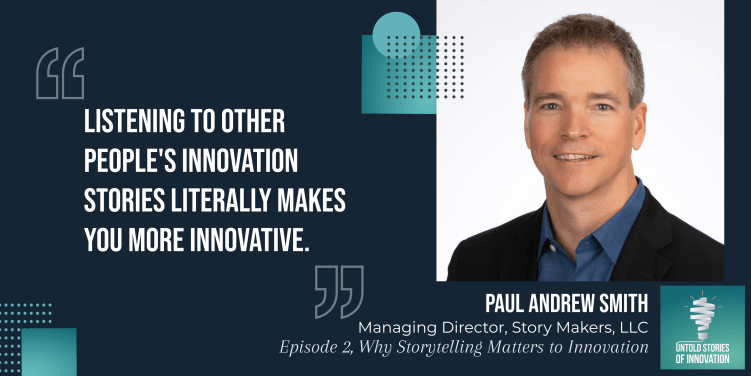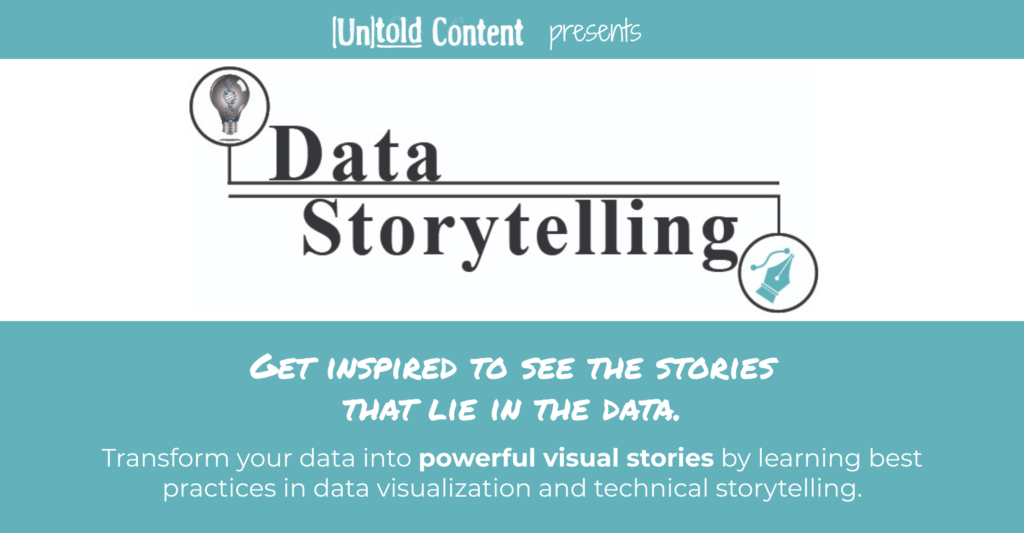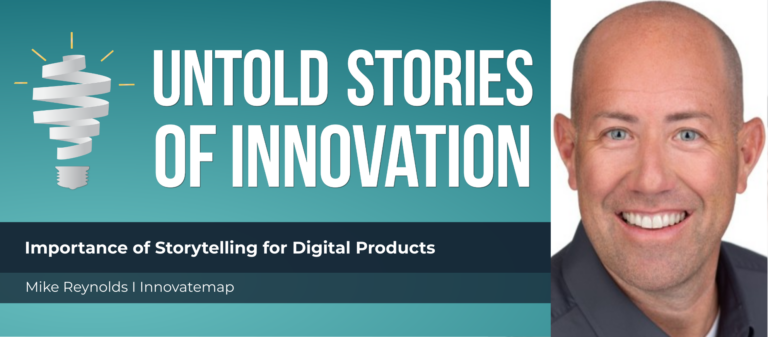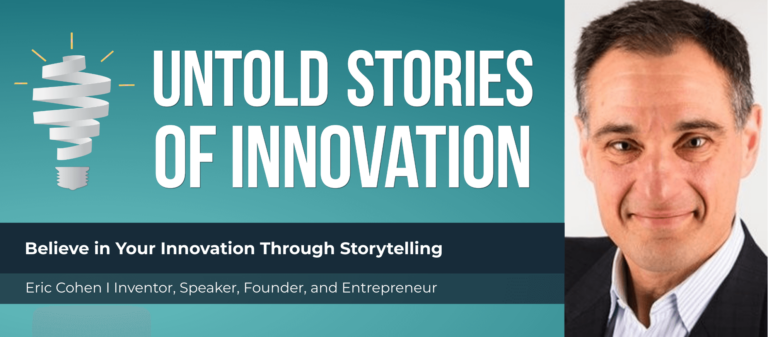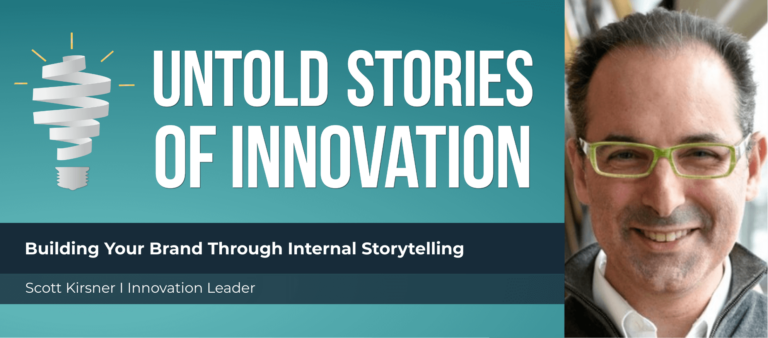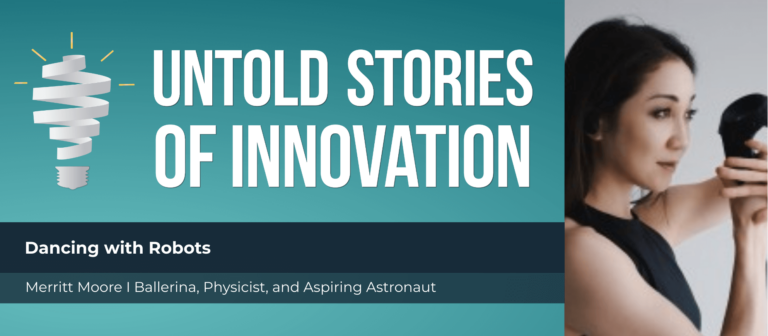Why Storytelling Matters to Innovation with Paul Andrew Smith
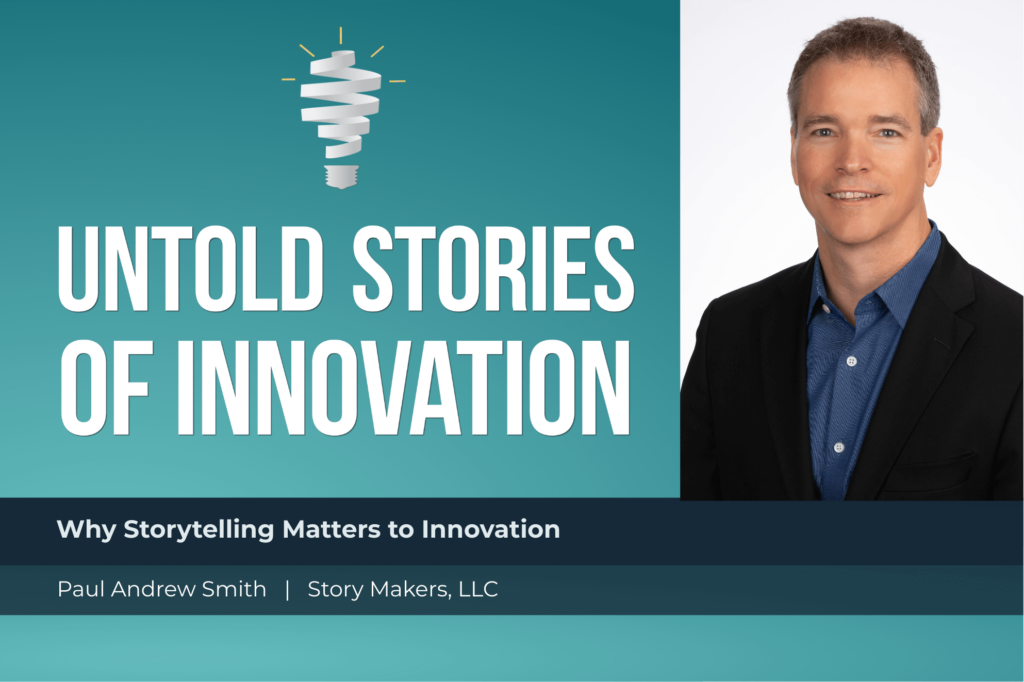
Why Storytelling Matters to Innovation - Untold Stories of Innovation
“Listening to other people’s innovation stories literally, I think, makes you more innovative. Just hearing that somebody else did something in a different industry, a completely different industry that was outside the box, done breaking the rules. Not only gives you a license to do it, but I think it literally gives you ideas for what can be done in your industry.” —Paul Andrew Smith
From today’s episode you’ll learn:
Why do stories matter to the innovation process? What values can be instilled in innovators who share stories? How do innovation leaders inspire creators to tell and share their success and failure stories?
We speak with Paul Andrew Smith, one of Inc. Magazine’s Top 100 Leadership Speakers of 2018, storytelling coach, and bestselling author of the books The 10 Stories Great Leaders Tell, Lead with a Story, Sell with a Story, Parenting with a Story, and Four Days with Kenny Tedford.

Paul Smith is one of the world’s leading experts in business storytelling, one of Inc. Magazine’s Top 100 Leadership Speakers of 2018, a storytelling coach, and bestselling author of the books The 10 Stories Great Leaders Tell, Lead with a Story, Sell with a Story, Parenting with a Story, and Four Days with Kenny Tedford. His work has been featured in the Wall Street Journal, Time Magazine, Forbes, Fast Company, The Washington Post, PR News, CIO Magazine, Investors Business Daily, Marketing Research Magazine, the American Banking Journal, and London’s Edge Magazine, among others. In his 20 years with Procter & Gamble, Paul held leadership positions in both research and finance functions, and most recently served as director of consumer and communications research. Prior to P&G, Paul was a consultant for Arthur Andersen & Company. His keynote speaking and training clients include international giants like Google, Hewlett Packard, Bayer Medical, Walmart, Kaiser Permanente, Ford Motor Company, Luxottica, and Procter & Gamble among dozens of others.
This episode, Why Storytelling Matters to Innovation is powered by data storytelling training from Untold Content and Data+Science. Transform your data into powerful visual stories by learning best practices in data visualization and technical storytelling. Whether you’re a PowerBI or a Tableau person—or just want to better communicate your data—this workshop will inspire you to see the stories that lie in the data. Learn more at untoldcontent.com/data-storytelling-training.
Katie: I’m thrilled this morning to have as our guest, Paul Andrew Smith. He is a bestselling author. He’s published several books on the art of storytelling in business, Lead with a Story, Sell with a Story and Parenting with a Story, as well as The 10 Stories Great Leaders Tell. Paul has been featured in The Wall Street Journal, Time Magazine, Forbes, Fast Company, Washington Post, you name it. He is a former P&G exec and now he travels the globe as a speaker and a trainer with companies like Google, HP, Bayer, Walmart, Kaiser Permanente, Ford, Lexotica, and dozens of others. Paul, I’m so thrilled to have you on the podcast to talk more about how storytelling can play a role in the process of innovation. Welcome to the podcast.
Paul: Yeah, thanks for having me. It’s good to be here.
Katie: Wonderful. I love to start each interview asking, what role does storytelling play in the innovation process?
Paul: Yeah, good question. Okay, so probably several. The ones that come to mind, first of all, is as a creativity booster. Listening to other people’s innovation stories literally, I think, makes you more innovative. Just hearing that somebody else did something in a different industry, a completely different industry that was outside the box, done breaking the rules. Not only gives you a license to do it, but I think it literally gives you ideas for what can be done in your industry. For example, one of my favorite examples of this, I heard myself while speaking at a conference, a conference for consumer researchers, by the way, and that’s relevant. During one of the breaks, somebody told me that they worked at a company that makes air conditioners, so window unit air conditioners. All right. I worked at the time at Procter & Gamble, we didn’t make window unit air conditioners. We made shampoo, and soap, and coffee, right?
But what they told me, one of their interesting research challenges at one point was, they wanted to develop an air conditioner that was super quiet, right? Because loud air conditioners are kind of an annoyance, right? The job of the researcher though, the consumer researcher, was to figure out, how much more would people pay for a super quiet air conditioner? The problem was their company hadn’t invented it yet, right? They just wanted to know how much more would people pay because if it was a lot, they’d probably be willing to invest more money to invent such a thing, right? Here this researcher had this challenge, “How do I do research and ask people, find out how much more money they’d pay for a quieter air conditioner.” Because they can’t just ask in a survey, “Well, how much more would you pay for an air conditioner that was 15 decibels quieter. Nobody knows what that means.
Katie: Yeah. How to even measure decibels? It’s really a quality of life question.
Paul: Exactly. Right, right. But they came up with a really creative, innovative, and super cheap way to test that. He said what they did was, they took their regular air conditioners, they opened up the front of it and they took all the guts out of it and then they put the front back on. Then they cut a four inch hole in the back of it and they attached a tube, a hose to the back of that air conditioner, and they installed that fake, empty air conditioner in the window of one of their test houses, right? The tube ran down the hallway to the room next door or two or three doors down the hallway where it was attached to the front of a regular air conditioner, the loud kind that works.
Then they marched a bunch of consumers through the test room and had them, “Well say go turn on the air conditioner, and they would go turn the air conditioner on and of course nothing happened. But at that exact moment, somebody who was watching through the video camera turned the real air conditioner on two doors down so that magically, almost, this crisp, clean air started flowing out of the front of this air conditioner but without making really much of a sound, right? They could vary the loudness of the sound by how close or far away they put the real air conditioner down the hallway from the fake air conditioner.
So this was a way to test how much more would people be willing to pay depending on how loud the air conditioner was without actually inventing the quiet air conditioner first. I just thought, “Gosh, at P&G we would’ve never done that.” We would have invented first. We would have spent years and months and millions of dollars trying to create or we would have created an elaborate system of speakers and to recreate the situation. Whereas gosh, oh my God, it was so simple. Just empty it out and connect it to a real one down the hallway. That kind of thinking just makes you realize, “Oh, I could probably apply that same kind of really outside the box thinking to my industry even if I don’t work in them.” So, stories like that, I think, serve a role in spurring creativity.
Katie: Absolutely. You think about, well, the methodologies that come to mind through that story relate back to the lean innovation process. Getting a minimum viable product. How much can you learn, how fast can you do it, how cheaply can you learn? In order to get the core insight you need to make a smarter, scalable solution. That’s a story, you know, you and I both sort of analyze story patterns. I love your books, I’ve read them. I follow your work and something that I really appreciate about how your mind works is that you break stories down into their functions and into their structures so that they’re repeatable by others.
That particular one, I’m thinking of how stories that are shared like that actually become lessons that create a culture. If I hear a story like that, and it’s day one for me in an innovation team, and I hear that from my innovation leader, I know that it’s okay to be agile, to rapidly test. I know that prototypes and MVPs are going to be valued more than year long, high budget experiments. I’m probably going to feel a little more comfortable failing and being able to fail on a smaller scale in order to get to the conclusion of the key insight you need to get to faster.
Paul: Yeah. Yeah. That’s one use, I think, of storytelling is to spur people to think of different ways to accomplish something in a creative way. Back to your original question, I think another purpose and use of storytelling in the innovation process is to help people recognize when there’s a need that needs to be filled. Because often, necessity is the mother of invention, right? Well you need to recognize the necessity. For example, the story that taught me this lesson happened at Armstrong International, which is this multinational conglomerate, they make all kinds of machines and things.
One of their salespeople went to visit one of his customers for the first day. It was a new job for him and so he wanted to go visit them at their manufacturing plant where they were going to use the big valves that this Armstrong International made. So they took them on a plant tour. He’s out there walking around the plant, being escorted by their executives or whatever, and he saw this forklift lift a big, huge, wooden crate way up into the air as they’re walking by and it gets higher and higher and higher. All of a sudden this big crate tips over and falls off of the forklift down eight, nine, ten feet onto the concrete floor, not too far from them and shatters into dozens of pieces and whatever was in it goes spilling out all over the floor.
Of course, he is the one that sees it happen. He yells, “Look out.” And he ducks, and he grabs somebody and pushes him aside, and he thinks he’s a hero and he’s saved everybody, and they just start laughing at him. He’s like, “What?” And they’re like, “Sorry that wasn’t an accident. We did that on purpose.” But it wasn’t a show for him or anything. He said, “Why would you drop that crate from so high and break it like that?” The forklift driver came over and explained, he said, “Well, that crate comes from one of our suppliers and they make this product that we need. But the crate is so well built and nailed and screwed together so tightly in the wood is really strong that it is just too hard to get open.”
I mean, it’s like the packages that you and I buy at the store with all the plastic, and you need the jaws of life to get it open. Well it’s kind of similar on a larger scale for them. He said, “It’s just hard to get this thing open and the thing that we buy that’s inside that crate is indestructible. So we just find that it’s easier to open the crate, just to drop it, and just let the crate break, and then the parts we need are just scattered over the floor and we just pick them up.” That just fascinated him and he walked over and picked up one of the pieces of wood from the shattered piece of crate and right there written on, it was his company’s name, Armstrong International.
Paul: That crate came from his company. That’s how he learned that, “Oh, we’re making our crates too strong. So much so that our customers are creating a safety hazard because it’s too hard to open up the package that we send our product in.” Nobody knew that until that moment. And so now they ship their product just on these little skids without all this fortress of wood around it because it’s obviously creating a problem. Nobody had complained about it, didn’t show up on their surveys, but it happened because he watched and noticed it. The purpose of that story is it teaches you the value of compensating behaviors. All right?
A compensating behavior means a behavior that your customer goes through because there’s something wrong with your product, right? Because there was something wrong with his package, they changed their behavior instead of opening it with a crowbar, like most people, they dropped it from the sky, right? If a customer is using your product in a way it was not designed to be used, that’s telling you something. It’s telling you you’ve done something wrong, right? You don’t need to look for people dropping your packages from the sky. I mean that of course it would tell you one thing, but the point is hearing that story, you can realize, “Oh, I need to consciously go out and look for my customers using my product in a way it was never designed to be used in that tells me there’s an improvement opportunity for me.”
Katie: Yes, yes. I’m thinking, you use the word behavior and I think that’s so critical, that sharing that particular experience with everyone back at headquarters, that it’s going to… Really that just shows the power of the story itself, the power that the story can have on the behavior of the company. Hearing that, hearing it come from leadership, the story really communicates that he was being observant, he was asking questions and trying to, like you said, get at the heart of why the customer was using it in that particular way. And yeah. I think the incremental innovation then, to show that this is how we value incremental innovation, here are the behaviors that are valued at the company, to support that storytelling can be an effective way of trying to elicit that and spread it across the company.
Paul: Right. Yeah. I can think of a couple more, if we have time.
Katie: I love it. Yeah, keep them coming.
Paul: Yeah. One of the other, I think, uses of stories to communicate the idea that innovation requires play, for lack of a better word. Sometimes to be creative, you have to have some freedom to explore and try things that you don’t know if they’re going to work. Oftentimes we’re taught in the business world to micromanage things and you can end up just micromanaging all of the creativity out of somebody because you’ve limited them so much. One of my favorite stories to help communicate that message is about a young boy. Nine year old boy named James. Nine year old James is in the kitchen with his mom and his mom’s sister.
While mom and auntie are sitting at the kitchen table having a cup of tea, James is standing at the stove watching the tea kettle boil. The look on your face tells me you may recognize this from the book. So yeah, don’t spoil the ending. Mom and auntie are having a cup of tea, and James is standing at the stove watching the tea kettle boil, and he’s just fascinated with it. He’s watching the jet of steam coming out the top of the tea kettle, and he’s got a spoon and he holds it up there into the jet of steam and watches as the steam condenses into little drops of water and they trickle down the spoon. They drip into a cup that he’s got sat there, and he’s just watching the cycle go over and over and over again. Just fascinated with it.
Well, eventually his mother just gets tired of him wasting his time. She just barks at him. She’s like, “James, go do your homework. Read a book. Go ride your bike. Go do something. Aren’t you ashamed of yourself just wasting your time like this?” Well, fortunately young James was undaunted by his mother’s admonition because 20 years later at the age of 29 and in the year 1765 James Watt reinvented the steam engine, ushering in the industrial revolution that we of course all benefit from today and all based on that fascination with steam that he developed at the age of nine in his mother’s kitchen.
Now, obviously she didn’t know that he was going to grow up to invent the steam engine. But the point is that sometimes you need to play with things that you have no idea what fruit it’s going to bear in order to be your most creative. So leaders, people who manage, people who are creatives and innovators, need to be super careful not to restrict them to, “You have to work on this project and this project.” And don’t give them any time to just play with ideas because that’s where a lot of the great innovation comes from, is playing with ideas.
Katie: I love that story so much. I think every innovator, at the heart of an innovator is childlike curiosity and creativity and being willing to bend the rules and that story brings that to life so well. There’s an example if you head over to the Nike innovation page, this is their recruitment page for potential innovators to join their teams. There is a really cool video that they’ve produced and it really just sets a cultural tone for, “If you’re interested in working with Nike and working at Nike and being creative, here are the rules we play by, we don’t play by rules.” Right, and that’s kind of part of their overall brand mission anyway. But the imagery from the video is sort of like hands caked in flour and eggs braking and sewing machines getting destroyed and it’s really like sort of a hodgepodge of images that harken to this idea of being playful and not having a lot of boundaries and rules around how you can create a different experience for athletes.
Paul: I like it.
Katie: Yeah. I think it’s neat to see companies owning, really at an organizational level, owning their identity as innovators. Do you have stories that speak to how that sort of culture of play gets permeated through story?
Paul: Something closely related. There’s a guy named Chris Ostoich who had founded a company and like an HR management company that I think is probably not in business anymore. But what he did there was close to that. Most companies have a policy moonlighting, right? Basically if you’re going to work here, you’re going to work here, don’t work anywhere else. He had a policy at this company about moonlighting also, but the policy was, everybody’s required to do it. Everybody in the company, if you want to work here and specifically in order to get hired, you had to show that you had some interest in something outside the industry they worked in and that you were passionately committed to.
Once you joined the company, you had to make sure you worked at least 25% of your time at either a volunteer job or one even where they got paid outside of their company. And if you ever dropped below 25% of your time working there, he’d fire you, right? Which just sounds bizarre but here’s why. It was a startup company that he started and at the same time he was on the board of directors of the local fine arts fund, okay? He would go to the board of directors meetings once a quarter or whatever. And every time he did, he would bring his notebook and he’d have his notebook out on the table in front of him.
On the left-hand side of the page, he would be taking notes for the board meeting that he was having. Things he had to go do and whatever. But on the right hand side of the page, he was writing down ideas for his company because a small fine arts fund fundraising board is kind of similar to managing a startup. It’s that they’re both small organizations with few people and some of them aren’t getting paid a whole lot yet. Anyway, there was enough similarities that the things, the problems, the challenges that the fine arts fund was having were similar enough to the challenges he was having running a fledgling organization that when they solved a problem at the fine arts fund, he would realize, “Oh, that could solve a problem that I’m having in my company.”
He realized, “Gosh, having this outside interest, being on this board of directors at this other company, not only is it not taking time away from my work, that’s becoming a burden, it’s doing the opposite. It’s actually helping me be better at my job. So he required everybody to have something that they’re passionate outside. He just, he found that it worked. One of his guys ended up volunteering for a political, not a person political campaign, but an idea, a law that they wanted to pass locally and he was raising money for it and getting people to volunteer for it.
What he ended up realizing was that many of those people ended up becoming their customers just because they knew him, right? So I mean even it could be that simple that you’re just meeting people outside that may end up becoming customers of yours. So every time every person had tried that, it ended up paying dividends. It’s similar to what you’re suggesting, he’s not creating a playful environment inside his company. He’s forcing them to go outside to do something they passionately enjoy or are committed to, to create the same benefit.
Katie: Definitely. It’s incredible. Yeah, it’s outside-in thinking. I think there’s a vulnerability to that and it breaks a traditional culture of what business is supposed to do. That you’re supposed to be loyal and steadfast and really the idea of getting out of the office and immersing in other disciplines, other ways of thinking, but always being mindful of how it applies back to your work. By doing that at a company level, he was not only just asking people to do it, he was making it visible too. So now it’s not just something that people might do, but they don’t talk about, now they’re telling stories about it, right? Because they know they have to.
Paul: And they’re encouraged to share what they learned.
Katie: Exactly. Exactly.
Paul: Yeah. Yeah. Now that you mentioned the Nike, it’s occurring to me that there are several companies in Silicon Valley that do something similar to that. Google, Facebook, Intuit, I know all of them have played with this idea of not requiring people to go outside, but giving them like 10% or 15% sometimes 20% of their time inside the company to do whatever they want. So 80%, 90% of their time is filled up with projects they’re assigned to. But the remaining time is like, “You work on whatever you want to work on and nobody’s going to ask questions.” That never happened anywhere I worked, right? I mean the boss wanted to know what you were working on all the time. So a similar idea, getting people to have some flexibility to play with interesting ideas.
Katie: I think as more individual professionals move into the world of consulting or want to become entrepreneurs or even if they stay in large companies, there’s that expectation that you bring your soul with you to work, that it seems even more critical now than it has been in the past. Where people stayed in one company for a long periods of time.
Paul: Yeah. Yeah. If you’re not happy there, you’re going to leave, so companies have to keep you happy. Yeah. Do you have time for one more?
Katie: Yes. Please, please.
Paul: I was thinking about Saatchi & Saatchi. The big advertising giant, right? One of their divisions, Saatchi & Saatchi X, which is a retail marketing firm centered down in Fayetteville, Arkansas. Was founded by a guy named Andy Murray and when he founded the company, and again, going through those growing pains of a fledgling company, he was always looking for ways for them to do their job more efficiently because he had a lot of business, not a lot of people to get it done. And it just took a long time for the project to move from the initial meeting with the client and to the research team and then to the design team and then to the production team and then getting it actually the marketing materials in store and all that.
He’s constantly looking for ways to do that more efficiently. He noticed that his son’s pediatrician was the best, A, the best pediatrician in town as rated by, whoever, people in town. But he also saw more patients than anybody else. He saw something on the order of 70 patients a day, right? Apparently most pediatricians in the area saw like half that many a day. And that still sounds like a full day to me. But he saw twice as many and he had the highest ratings of what is it, not bedside manner, but whatever, patient-
Katie: Patient experience. Yeah.
Paul: Yeah, yeah. So they thought he was the best doctor, and he was the nicest doctor, and he was the busiest doctor. And those things just don’t add up, right? Usually the busiest doctors, the one that’s kind of a jerk to you. They’re like, “Yeah. Get in and get out. I took your temperature, now leave.” Whatever. He got a 69 other patients to see. So he got fascinated with him and he asked the guy to come and visit him at his office and explain his process, “How can you do that when none of the other doctors in town can do it?” It turned out, it wasn’t so much in the doctoring, it was in the nursing.
The way his nurses managed him was that they had a folder that went with each patient. It had all their paperwork or whatever when they checked in, and then he walked in there and he did his analysis of the patient and inside the folder was a Dictaphone. He was supposed to pull out the Dictaphone, he would evaluate the patient and he would turn on the Dictaphone and he would talk, I guess to the Dictaphone. But the patient’s right in front of them. So he’s kind of talking to both of them and he’s telling them, and the Dictaphone, the results of his examination, what his conclusion is and what he recommends, “You need to take this medicine, you need to…” Whatever their prescription is.
Then you put the Dictaphone back in the envelope and just hang it on the inside of the door where it was when he got there and then he would leave. The nurse would then come in, get the Dictaphone, go back and transcribe it, get the prescription ordered from the pharmacy and everything got done by them in the back room. Whereas normally the way a doctor, all his competitors, what they would do is they would come in, they would evaluate the patient, they would take some notes and then at then they just hang onto those notes until the end of the day. Then they’d go back through all their notes, “Okay. For patient number one, we need to do this.” And then they would call in the prescription or they would do whatever they need to do.
But by then, they’ve kind of forgotten some of it and ideas aren’t as fresh. And the patients never see any of this normally, right? They don’t know what the doctor does after they walk out of the room. But he did all that stuff right in front of the patient, which because of the Dictaphone and the nurses doing what they’re doing, made it more efficient so he could see more patients. But importantly, all the time that he was spending analyzing and making decisions and dictating what to do was done in front of the patient instead of in a back room. So the patient could hear everything, all of his conclusions and they felt like they had better rapport with the doctor. They felt like they understood their condition better, they understood the prognosis, they understood what they were supposed to go do because they weren’t just reading it on some scribbled little piece of paper and nobody can read doctor’s handwriting anyway, right? So it made not only a better customer experience, but a more efficient one.
So now he started doing his business that way. They had a folder for every client. Then it would go from the intake department to the research department, to the design department, to the production department, to the shipping department. And everybody knew what happened in the one before. So just the point is, he learned about how to run his business more efficiently from a completely different industry who’d figured out how to do it more efficiently. Our natural instinct is to try and be as efficient as the most efficient competitor in our industry. What he learned was that, well, that good enough he was already the most efficient competitor in his industry. But he learned something from outside the industry by looking at somebody else. So I don’t know, if you wanted to evaluate speed like that, evaluate how a NASCAR driver, what they do in the pit, right? Don’t evaluate other people in the delivery business like you’re in. Look outside the industry.
Katie: Yeah. And that’s how disruption can happen.
Paul: Yeah, exactly. Exactly.
Katie: Incredible. Thank you by the way, every story you shared holds value and it reminds us to be curious, to be interdisciplinary, to look outside of our own verticals and I think all of that also fosters collaboration and those are all attributes of a strong innovator.
Paul: Amen to that.
Katie: I want to conclude by asking you, of all the innovation stories that are out there, what sort of pattern is your favorite? There’s the Garage Guru, the person who is the solo genius in the garage coming up with something that’s going to disrupt the entire world. There is the perspiring innovator, the one who just tries again and again and again and goes back to the lab bench every day until they discover the right solution to the challenge, or there’s the sort of surprise discovery. From a personal standpoint, do you have a personal favorite when it comes to the kinds of innovation stories that gets your heart racing?
Paul: Yeah. That’s a good question. I think it’s not the first two for sure. The reason is because, I don’t think that’s replicable, if that’s a word, right? You can’t just tell somebody, “Hey, you need to be a lone genius.” You need to be a Bill Gates or what… You just can’t teach somebody to do that. So that those-
Katie: You’re right. It’s kind of self-defeating. I’m thinking of what do we want to teach our children, do we want to teach our children that if you’re really, really lucky and you work all by yourself, that magic will happen?
Paul: You can change the world. So it’s not those two for sure. I think to me, and maybe this is the third one, or maybe it’s something even different for me, it’s one that teaches us more how to be more creative, even if we’re not the natural born creators by, and not just working harder. That’s just so cliche and I don’t want to tell people, “You need to work your life away to fritters.” I think it’s being more observant because I think you can teach people to do that. For example, the guy who figured out the whole electromagnetic spectrum back in the sixteen hundreds, okay? I think it’s Hans Christian Oersted.
Before that scientist had known about electricity and they had known about magnetism but nobody had figured out there’s this thing called electromagnetism that is responsible for the light waves that we see by, and the radio waves that we listened by, and internet signals you and I are using right now, microwave ovens. Nobody had discovered that interaction between electricity and magnetism until this guy. But it turns out he wasn’t the first person to notice the phenomenon. Literally the way it was discovered was, he was doing a demonstration to a bunch of students. He was a professor, a physics professor and a Danish guy.
He had this little electric circuit on the demonstration table. Little wires and batteries hooked up to him and a voltmeter showing that. And there was a magnet sitting somewhere on the table and it was in the way, so he reached over and grabbed it and just shoved it out of the way. And when he did that, the little meter kind of fluctuated and he thought, well, that’s kind of weird. That has nothing to do with the electric current. So he moved it back and moved it away again and it did it again. And he thought, “Well, that’s weird.” Well, anyway, he just put it aside and finished his demonstration. Later that day he asked his assistant, “Hey, have you ever noticed that when you have a magnet somewhere near an electric circuit that it kind of makes the electric circuit go haywire?”
The kid’s response was, “Yeah, yeah, it happens all the time. So we just make sure we keep the magnets in the cabinet when we do those.” Yeah, sure it just didn’t occur to him that, that was interesting. But that fascinated Hans Christian Oersted. So he looked into it and he realized that that was significant and he discovered electromagnetism that way. So he wasn’t the first person to notice it. So he wasn’t just lucky, right? Or early. He was the first person to realize the significance of that weird thing that just happened. That I think we can learn and do ourselves if we’re not just born this lone genius. Be observant and look for weird things that don’t make sense. Be curious. I think you can train yourself to be curious. You can just decide to be curious, but you can’t just decide to be a genius-
Katie: Or to be lucky.
Paul: Or be lucky. But I think you can decide to be curious and that I think is what leads to innovation that is replicable.
Katie: I love that. Yes, that is such a powerful way to conclude our time together. I’m so grateful for this conversation and I hope that the entire innovation community is inspired by some of these insights. So thank you so much for joining us today. It’s been such an honor to talk with you.
Paul: You’re very welcome. Thanks for having me on. That was fun.
Katie: Thanks, Paul. Bye.
You can listen to more episodes of Untold Stories of Innovation Podcast.
*Interviews are not endorsements of individuals or businesses.

